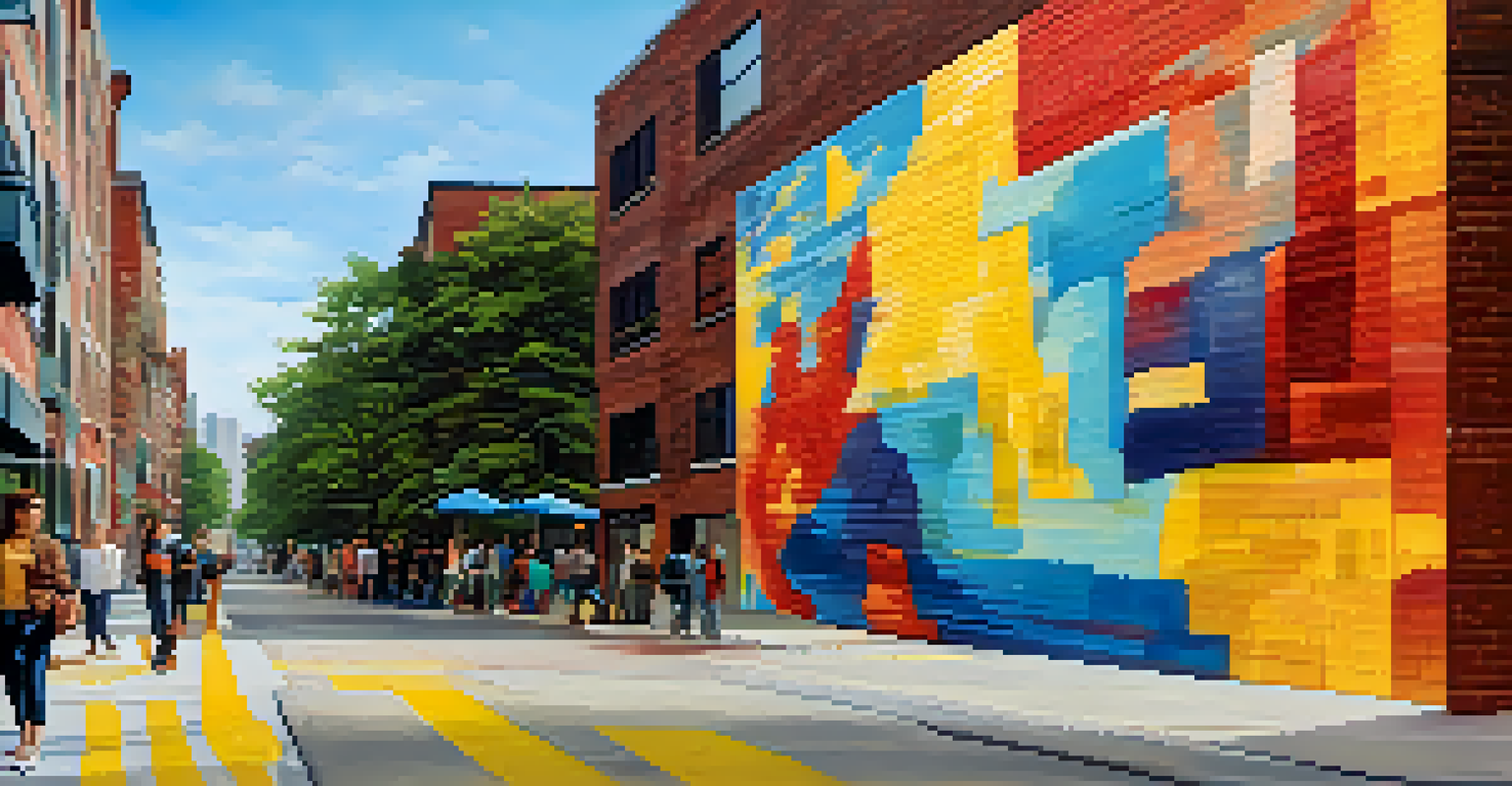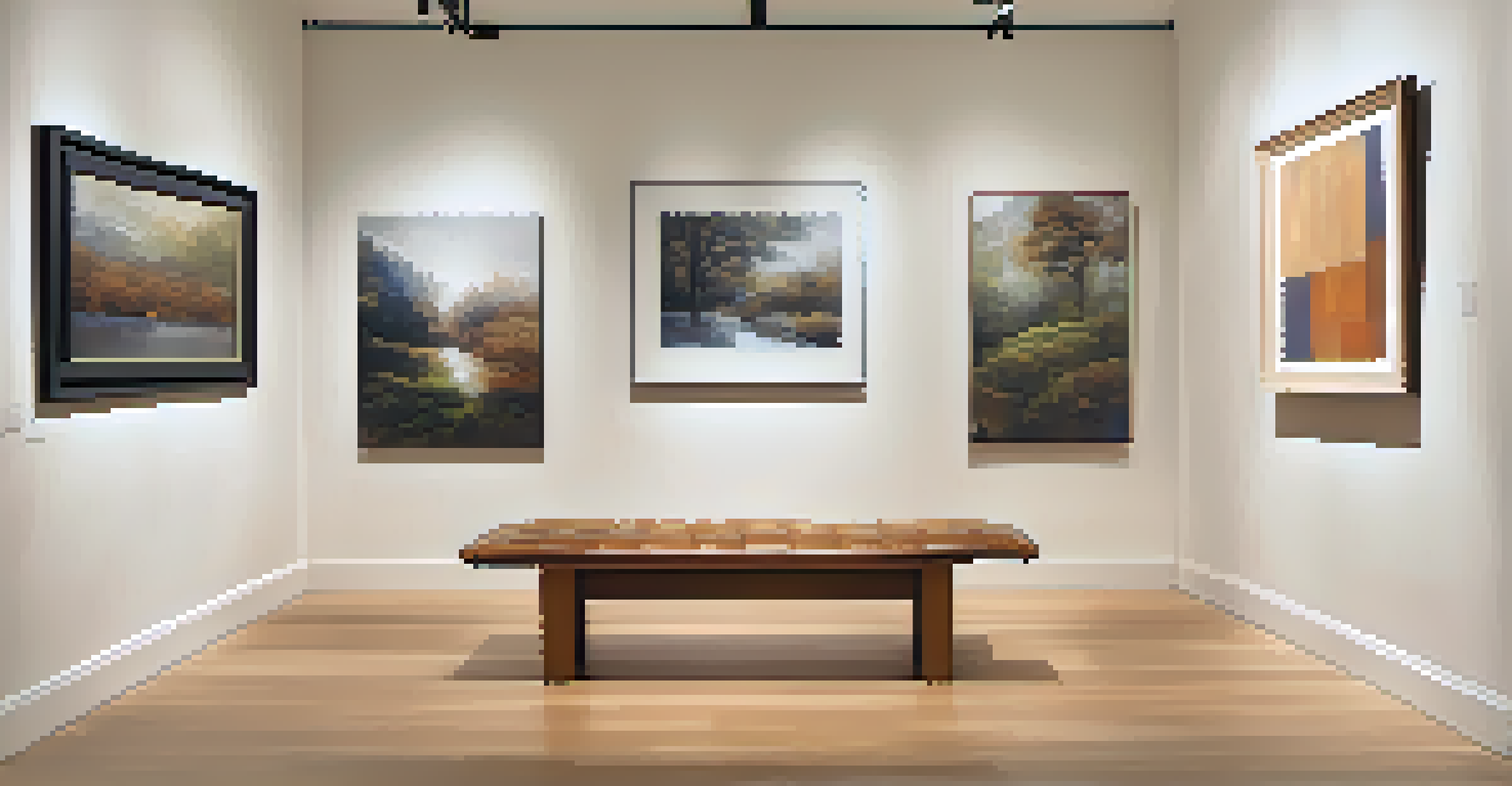The Role of Context: How Environment Influences Art Perception

Understanding Art Context: What Does It Mean?
Art context refers to the various factors surrounding a piece of art, including cultural, historical, and physical environments. These elements help shape our interpretation and emotional response to the artwork. For instance, a painting viewed in a bustling gallery may evoke different feelings compared to the same piece displayed in a quiet, intimate space.
Art is a reflection of our times, and the context in which it is created shapes its meaning.
When we talk about context, we are also discussing the artist's background and the era in which the piece was created. Understanding the socio-political climate during the time of creation can significantly influence our perception. For example, works emerging from periods of turmoil may resonate with feelings of struggle or hope, depending on the viewer's own life experiences.
Ultimately, context acts as a lens through which we view art, guiding our understanding and appreciation of the piece. By recognizing this role, we can deepen our engagement with art and explore the myriad meanings it can convey.
The Influence of Physical Space on Art Experience
The physical environment where art is displayed plays a crucial role in how it's perceived. For example, a large mural in an urban setting can feel vibrant and alive, whereas the same mural in a dimly lit room may lose some of its impact. The surrounding ambiance, lighting, and even the architectural style of the venue can shape our emotional connection to the artwork.

Consider museums, which are often designed to provide an optimal viewing experience. The layout, flow of foot traffic, and distance between artworks all contribute to how we interact with each piece. A well-curated exhibition can guide viewers through a narrative, enhancing their understanding and appreciation of the art on display.
Art Context Influences Perception
The context surrounding a piece of art, including cultural, historical, and personal factors, significantly shapes our interpretation and emotional response.
Moreover, installation art thrives on the interplay between the artwork and its environment. Artists like Olafur Eliasson use natural elements and space to create immersive experiences, inviting viewers to engage with art on a sensory level. This connection between art and space can elevate our understanding and appreciation of the work.
Cultural Context: How Society Shapes Art Interpretation
Culture plays a pivotal role in shaping our perceptions of art. Different societies have unique values, traditions, and historical narratives that influence how art is created and understood. For instance, an abstract piece may be celebrated in one culture while dismissed in another that favors realism.
Art is not what you see, but what you make others see.
The cultural background of the viewer can also alter their interpretation of a piece. If an artwork references symbols or themes specific to a particular culture, those familiar with them may derive deeper meanings than those who are not. This highlights the importance of cultural literacy in understanding global art.
In a globalized world, cross-cultural exchanges are increasingly common in the art scene. This blending of influences can lead to richer dialogues and new interpretations, as artists draw from diverse backgrounds and experiences. It reminds us that art can serve as a bridge between different cultures, inviting viewers to explore unfamiliar perspectives.
Historical Context: Understanding Art Through Time
Art is often a reflection of the historical period in which it was created. Significant events, movements, and changes in society can deeply influence artistic expression. For example, the Impressionist movement emerged in response to the rapid industrialization of the late 19th century, capturing fleeting moments of everyday life.
Examining the historical context allows us to appreciate the intentions behind the artwork. Understanding an artist's motivations and the events that inspired them can lead to a more profound appreciation of their work. For instance, knowing that Picasso's Guernica was a reaction to the Spanish Civil War adds layers of meaning to the piece.
Physical Space Affects Experience
The environment where art is displayed can enhance or diminish its impact, highlighting the importance of layout and ambiance in art appreciation.
Additionally, as time progresses, the interpretation of historical art can evolve. What may have been controversial or misunderstood in one era can be reevaluated and appreciated in another. This dynamic nature of art history emphasizes the importance of context in shaping our understanding of artistic movements.
Personal Context: Individual Experiences Shape Art Perception
Each viewer brings their own experiences, emotions, and memories to the art they encounter. This personal context significantly influences how one perceives and connects with a piece. For example, someone who grew up near the ocean may have a profound emotional response to a seascape painting because it resonates with their cherished memories.
Our individual backgrounds, including factors like age, education, and cultural identity, color our understanding of art. A young person may relate to contemporary art differently than an older individual, simply due to generational differences in cultural references and experiences. This uniqueness makes the art experience personal and subjective.
Moreover, art can serve as a mirror, reflecting our own thoughts and feelings. When we encounter a piece that resonates with our struggles or joys, it can evoke a strong emotional reaction. This personal connection can turn a simple viewing into a transformative experience, highlighting the profound impact of context on art perception.
Digital Context: The Role of Technology in Art Interaction
In today's digital age, technology is reshaping how we engage with art. Online galleries, virtual exhibitions, and social media platforms allow art to reach wider audiences than ever before. However, this shift also changes the context in which we experience art, often reducing the tactile and sensory elements that physical spaces provide.
For instance, viewing artwork on a screen can alter our perception of scale and texture. A vibrant painting may lose some of its impact when viewed on a small device, as the nuances of color and detail may not translate effectively. This raises questions about how digital context influences our understanding of art.
Digital Age Changes Art Interaction
Technology is transforming how we engage with art, offering new ways to experience and interpret pieces while also posing challenges to traditional perceptions.
Conversely, technology can also enhance our art experience by providing access to information and interactive elements. Augmented reality apps can offer additional layers of understanding, allowing viewers to engage with the artwork in new ways. This blend of technology and art creates a unique context that continues to evolve, inviting us to explore how digital environments influence our perceptions.
Conclusion: Embracing the Complexity of Art Context
The role of context in art perception is multifaceted, encompassing physical, cultural, historical, personal, and digital dimensions. Each of these elements shapes how we understand and appreciate artwork, fostering a richer engagement with the pieces we encounter. By recognizing the importance of context, we can deepen our connection to art and explore diverse interpretations.
As we navigate through different contexts, it becomes clear that art is not a static entity; rather, it is a dynamic conversation between the artist, the artwork, and the viewer. Each interaction is unique, shaped by individual backgrounds and the environments in which art is experienced. This complexity invites us to remain open-minded and curious about our perceptions.

In the end, embracing the interplay of these contexts not only enriches our art experiences but also fosters empathy and understanding. Art has the power to transcend boundaries, and by appreciating the role of context, we celebrate the diversity of perspectives that make the world of art so vibrant and meaningful.